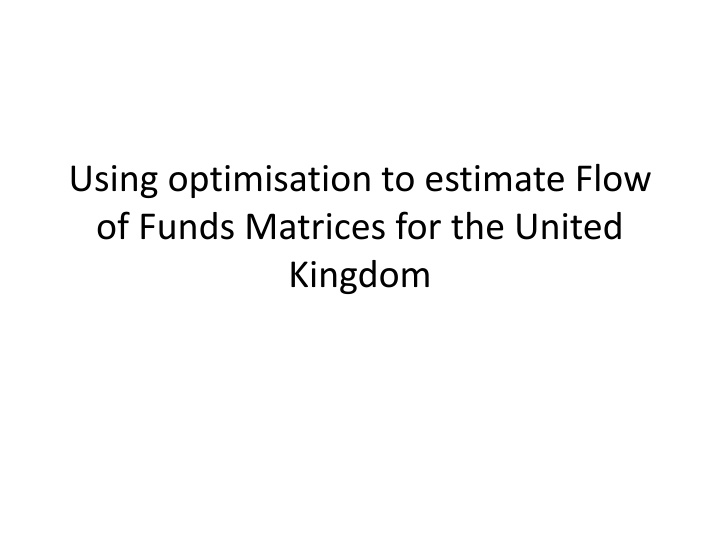
Optimizing Flow of Funds Estimates in the UK Economy
Explore the use of optimization techniques to estimate Flow of Funds matrices for the United Kingdom economy, addressing challenges of data adjustment and adherence to asset/liability constraints. Learn about the literature review on related processes and the application of quadratic optimization for automated adjustments in financial datasets.
Download Presentation

Please find below an Image/Link to download the presentation.
The content on the website is provided AS IS for your information and personal use only. It may not be sold, licensed, or shared on other websites without obtaining consent from the author. If you encounter any issues during the download, it is possible that the publisher has removed the file from their server.
You are allowed to download the files provided on this website for personal or commercial use, subject to the condition that they are used lawfully. All files are the property of their respective owners.
The content on the website is provided AS IS for your information and personal use only. It may not be sold, licensed, or shared on other websites without obtaining consent from the author.
E N D
Presentation Transcript
Using optimisation to estimate Flow of Funds Matrices for the United Kingdom
Introduction ONS has agreed to publish the Flow of Funds (FoF) on an experimental basis in 2020 The Flow of Funds is a dataset describing the financial assets and liabilities held by the various institutional sectors of the UK economy (corporations, banks, government, etc) and some non-UK assets/liabilities, and who holds the corresponding liabilities/assets For example: one cell of the FoF consists of bank loans (assets) to households (liabilities debt)
The Problem There are multiple data sources, which will give different results, so they have to be adjusted to create a single value for each cell Also, the equation B.9n = B.9f must hold, which in effect imposes an external limit on the change of the asset/liability sum in each time period; the cells have to be adjusted to make this hold, too These adjustments should be partly automated
Literature Review (1) What literature exists on the processes used by central banks for making these adjustments? Very little! What literature exists on automating these processes? None! But
Literature Review (2) a literature does exist on a related problem automating the supply-use balancing process (At least) five National Statistics Institutes (US, Sweden, Italy, Netherlands, Australia) have published papers on this And SU balancing is a similar problem
Literature Review (3) In all these papers, the model is a quadratic optimisation This is an algorithm to find an optimal solution (in terms of an objective function) given certain constraints The objective function to be minimised is the squared sum of the adjustments (weighted for the quality of the data sources) And the constraints are the SU accounting rules
Applying QP to the FoF Constraints will be mathematically derived from the FoF rules Objective function will be the same as for SU sum of squares weighted by quality How to quantify the quality of a cell?
Quality Measure - Problem SU literature shows that ideally this would be determined by the covariance matrix underlying the data However, we do not know the covariance matrix in the SU context (Chen) Nor do we know it in the FoF context (see lack of literature on calculation process So what else can we do?
Quality Measure - Solution The Australian NSI paper allocates each cell in the SU matrix to one of 3 quality levels (A, B, C) Each cell with a given quality level has the same weight in the objective function so all A cells might have 0.8, all B cells might have 0.6, etc. We adopt this solution as it fits the limited quality information available and allows us to automate But
Limited Claims Chen (2012) and other NSI automated SU papers show that under ideal conditions the QP solution is a Maximum Likelihood Estimator (MLE) of the true solution In addition to a known w/o error cov matrix, the data must be normally distributed and measured without bias We have no evidence for any of this So we do not claim that the result will be a MLE or a best linear unbiased estimator The sole aim is to defensibly automate the adjustment process
